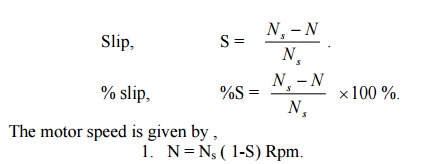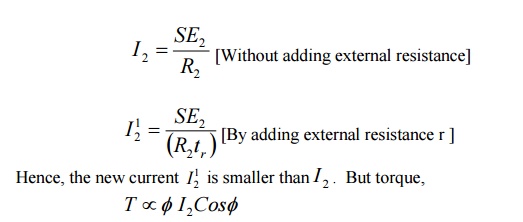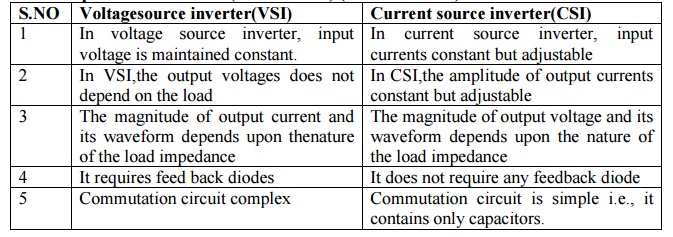Chapter: Electrical Drives & Control : Conventional and Solid State Speed Control of A.C Drives
Important Short Questions and Answers: Conventional and Solid State Speed Control of A.C Drives
Conventional & Solid State Speed Control of
AC Drives
1.What are the speed control methods available for speed control of
induction motor on stator side?
Speed control methods available for speed control from stator side are:
i. By controlling supply voltage
ii. By pole
changing
iii. Changing
supply frequency
What are the speed control methods available for speed control of
induction motor on rotor side?
The speed control methods available for sped control of IM on rotor side are;
i. Rotor resistance control
ii. Cascade speed control
iii. By
injected voltage method.
What are the three possible speeds that can be obtained in cascaded
operation of induction motor?

What are the disadvantages of inserting resistance in the rotor
circuit in slip ring induction motor?
Disadvantages:
Losses (I2R) is
increasing and efficiency of the motor is decreased.
Since speed is dependent on both resistance and
load. We can change speed for short periods only.
under what condition, the slip in an induction
motor is
Negative
Greater than one
Slip of an induction motor is
negative when the induction motor is operating in generating mode.
Slip of an induction motor is
greater than one when the induction motor is operating in the braking mode (its
direction is opposite to the direction of rotating magnetic field).
How the speed is controlled by changing the
supply voltage?
Since,
Torque, T
µ V 2
By changing the supply voltage, torque is
proportional to the square of the supply voltage. Hence, example if voltage is
reduced by half (1/2), the torque will be reduce d by (1/4) quarter.
How the speed is changed by changing the supply frequency?
Since

By changing the supply frequency directly, the
speed is reduced directly.
What is „slip‟ in an induction motor?
The induction motor speed is always less than
the speed of synchronous speed of revolving flux. The difference in speed
between synchronously revolving flux and the rotor speed is called slip speed.
The ratio between the slip speed and
synchronous speed of induction motor is called slip. It is denoted by„s‟.

How the speed is controlled by changing the supply voltage?

Speed is inversely proportional to number of
poled, the speed decreases with increase in number of poles.
However, torque capability of motor increases
with increase in number of poles.
How speed control can be achieved by inserting resistance in the
rotor circuit of slip ring induction motor?
By inserting external resistance in the rotor
circuit of slip ring induction motor, the total rotor circuit resistance is
increased. For a particular motor speed, the induced emf in the rotor is
constant. Hence, with increase in the rotor circuit resistance, rotor winding
current wills decreases.

Since I2 is decreased torque is
decreased and the motor is peed starts to fall.
When motor speed is reduced, the term SE2 will be becomes increased since slip S is increased. Hence with decrease in motor speed, rotor circuit current I2 will increase and hence the torque will goes on increasing.
The motor will attains a speed at which I 2 = I1 condition achieved ie the motor is able to handle the
load torque.
What is slip power?
It is the power wasted in the rotor circuit
resistance. IN case of slip ring induction motor, the speeded control is
achieved by adding external resistance in the rotor circuit. But, with adding
external resistance in the rotor circuit, (I2R) losses in the
external resistances will be increased. Hence, slip power is wasted in rotor
resistance.
Without wasting this slip power, the slip power
can be usefully utilized in slip power recovery scheme.
What is slip power recovery scheme?
The power wasted in the external resistance in
the rotor circuit in case of slip ring induction motor, is called slip power.
This wastage slip power can be usefully fed back to the source by used of slip
power recovery scheme.
Two types of slip power recovery scheme
available are;
Static scherbius drive
Static Kramer‟s drive
What is meant by inverter?
A device that converts dc power into ac power
at desired output voltage and frequency is called an inverter
What are
the applications of inverters?(UQ)
Adjustable speed ac drives
Induction heating
Stand by air-craft power
supplier
UPS
HVDC transmission
What is
the main classification of inverters?
Voltage source inverter(VSI)
Current source inverter(CSI)
What is
meant by VSI?
A VSI, is one in which the dc source has small
or negligible impedence. In other words a VSI has stiff dc voltage source at
its input terminals.
What is meant by CSI?
A current fed inverter or CSI is fed with
adjustable current from a dc source of high impedance is from a stiff dc
current source.
Give two advantages & applications of CSI?
Advantages
CSI does not require any
feedback diodes.
Communication circuit is
simple as it contains only capacitors.
Applications
Induction heating
Lagging VAR compensation
Speed control of AC motors
Synchronous motor sharing
How the thyristor inverters are classified?
According to the method of
commutation
Line commutated inverter
Forced commutated inverter
According to the connection
Series inverter
Parallel inverter
Bridge inverter
What is meant by series inverter write its
applications?
Series inverter means commutating elements L
and C connected in series with load.
The thyristorised series inverter produces an
approximately sinusoidal waveform at a high output
frequency, ranging from 200HZ to 100KHZ.It is
commonly used for fixed output applications such as
Ultrasonic generators
Induction heating
Sonar transmitter
Fluorescent lighting
Compare VSI and CSI?

Voltagesource inverter(VSI)
In voltage source inverter, input voltage is
maintained constant.
In VSI,the output voltages does not depend on
the load
The magnitude of output current and its
waveform depends upon thenature of the load impedance
It requires feed back diodes
Commutation circuit complex
Current source inverter(CSI)
In current source inverter, input currents
constant but adjustable
In CSI,the amplitude of output currents
constant but adjustable
The magnitude of output voltage and its
waveform depends upon the nature of the load impedance
It does not require any feedback diode
Commutation circuit is simple i.e., it contains
only capacitors.
Related Topics